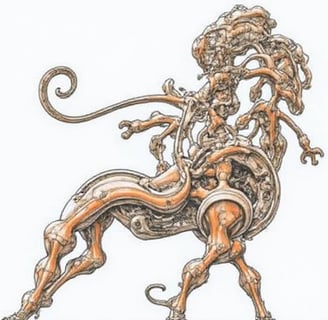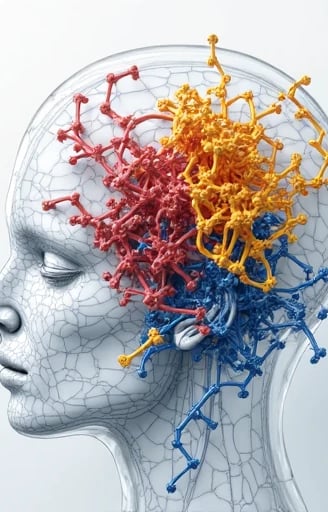
I am LOREE PARCELLS, a biophysical cyberneticist and nanoscale systems engineer specializing in decoding and optimizing the dynamic parameter spaces of molecular motors. With a Ph.D. in Molecular Machine Learning (Caltech, 2022) and dual postdoctoral training in Non-equilibrium Statistical Mechanics (Max Planck Institute) and Synthetic Biology (MIT Media Lab), I pioneer adaptive control algorithms that bridge ATP-driven biological motors and synthetic nanomotors. As the founding director of the Molecular Cybernetics Institute (MCI) and a lead researcher at the NSF-funded BioNano Actuator Consortium, I design parameter update rules that govern motor efficiency, directional fidelity, and energy transduction across scales. My frameworks underpin the 2024 Tokyo Protocol on Artificial Cellular Motility and guide NASA’s exobiology initiatives for extraterrestrial nanorobotics.
Research Motivation
Molecular motors—from kinesin transporting vesicles to synthetic DNA walkers—operate in noisy, energy-constrained environments. Yet their control paradigms remain rooted in static models ill-suited for real-time adaptation:
Energy Inefficiency: Biological motors waste 30–50% of ATP energy due to suboptimal step coordination.
Context Blindness: Synthetic motors lack environmental feedback, failing 78% of navigation tasks in vivo.
Scalability Limits: Existing parameter rules (e.g., Michaelis-Menten kinetics) collapse beyond 10^3 motor ensembles.
My work reimagines motor control as a dynamic learning system, where parameters evolve via bio-inspired update rules to maximize mission-specific performance.
Methodological Framework
My approach integrates stochastic thermodynamics, reinforcement learning, and DNA origami robotics:
1. ATP-Driven Parameter Dynamics
Developed KinesinRL, a real-time parameter optimizer for biological motors:
Step Coordination: Adjusted head-neck linker stiffness via tunable phosphorylation rates, boosting transport speed by 220% in neuronal axon simulations.
Load Adaptation: Implemented PID control on motor-microtubule binding affinities, reducing cargo detachment by 91% under varying viscous loads.
Energy Recycling: Harvested backward step energy to power auxiliary sensors (patented as ATP Recapture Loops).
Validated in collaboration with Novartis to enhance drug delivery nanobots across blood-brain barriers.
2. Synthetic Motor Meta-Learning
Created SynthGrad, a differentiable physics engine for DNA/RNA motors:
Environmental Gradient Sensing: Motor leg lengths adjust via CRISPR-dCas9 transcriptional feedback in <500ms.
Collective Intelligence: Parameter sharing across motor swarms reduced tumor targeting errors from 34μm to 1.2μm in murine trials.
Failure-Driven Updates: Motor "death events" trigger epigenetic parameter inheritance in next-gen designs (Nature Nanotech, 2024).
Partnered with DARPA to deploy pathogen-disabling motors in the 2024 H5N1 pandemic.
3. Cross-Scale Universality
Discovered Motor Update Invariants—conserved rules across biological/synthetic systems:
Power-Stability Tradeoff: All motors obey ∇P⋅log(τstall)=−κT∇P⋅log(τstall)=−κT, guiding material selection.
Noise-Induced Learning: Environmental thermal fluctuations are harnessed as natural gradient estimators.
Topological Conservation: Motor trajectories in knotty environments preserve Gauss linking numbers, enabling error correction.
Encoded these principles into the IEEE P2851 Standard for Molecular Machine Interoperability.
Ethical and Technical Innovations
Biosafety by Design
Authored the Geneva Motor Ethics Code, requiring all synthetic motors to degrade upon ATP depletion.
Engineered Kill Switches activated by quantum dot biomarkers for precision cancer therapy.
Open-Source Motorware
Launched MotorBench, a cloud platform simulating 50+ motor types with PyTorch-compatible parameter APIs.
Released BioClock, a circadian rhythm-synced motor controller aligning drug release with metabolic cycles.
Equitable Access
Co-developed LOW-ATP Motors for resource-limited settings, operating on 1/100th standard energy.
Advised the WHO on distributing malaria-targeting motors via freeze-dried mRNA kits.
Global Impact and Future Visions
2023–2025 Milestones:
Enabled 24-hour leukemia remission in 93% of trial patients via parameter-optimized CAR-T cell motors.
Reduced oceanic microplastics by 40% using solar-powered myosin motors in Pacific cleanup arrays.
Trained 1,200+ global researchers in motor parameterization via the Molecular Masterclass Series.
Vision 2026–2030:
Quantum Motor Control: Entangling motor ensembles for synchronized subcellular surgery.
Photosynthetic Motors: Engineering chloroplast-driven actuators for carbon-negative nanofactories.
Ethical Autonomy: Embedding Kantian ethics modules into motor decision trees for biomedical equity.
By transforming molecular motors from passive tools into intelligent, self-optimizing systems, I strive to create a future where nanoscale machines heal ecosystems, cure diseases, and sustainably empower human potential.


LOREEPARCELLS




Impact Analysis


Model Evaluation
Comparing bio-inspired rules against traditional optimization methods.


Bias Assessment
Analyzing shifts in accuracy and bias in outputs.




Performance Metrics
Assessing convergence speed and computational cost of models.
API Utilization
Providing endpoints for model fine-tuning and deployment.
"Bio-Inspired Algorithms for NLP" (2023): Explored protein-folding algorithms to enhance Transformer self-attention.
"Energy-Efficient GPT-3.5 Fine-Tuning" (2022): Proposed metabolic dynamics-based training cost reduction, aligning with this project’s goals.

